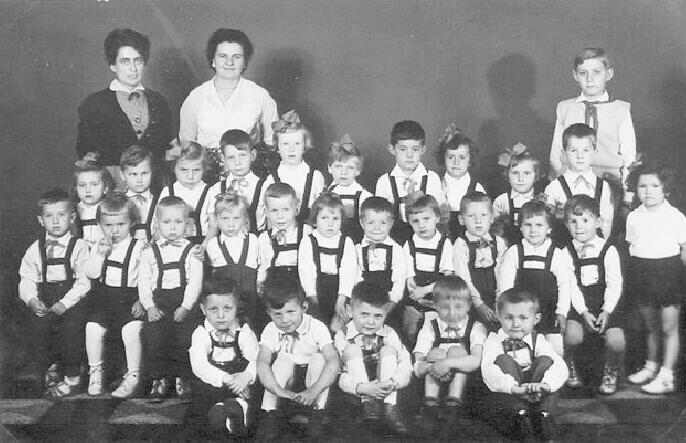
Russian Kindergarten (about 1960)

Figure 1.--The Soviet kindergarten was probasbly taken in the late-1950s or early 60s. They look a little younger thab 5-year old kindergarten children. Note similiar design of boys' h-bar shorts and girls' skirts. But they wore a variety of hosiery: ankel socks, knee-length socks, white and dark long stockings. Note the older boy in the upper left. He's a Young Pioneer leader of that childern group-- " vozhaty " in Russian. It was a common practice for boys and girls at a school to work with the younger children and help the teachers.
|
The Soviet kindergarten was probasbly taken in the late-1950s or early 60s. They look a little younger than 5-year old kindergarten children. Note similiar design of boys' h-bar shorts and girls' skirts. But they wore a variety of hosiery: ankel socks, knee-length socks, white and dark long stockings. Note the older boy in the upper left. He's a Young Pioneer leader of that childern group-- " vozhaty " in Russian. It was a common practice for boys and girls at a school to work with the younger children and help the teachers.
The School
We at first thought the Soviet school group here was a Soviet kindergarten. Some of the children, however, seem younger than 5 years of age. Perhaps Soviet kindergartens accepted younger children.
Chronology
The class photograph here was probasbly taken in the late-1950s or early 60s.
Clothing
Note similiar design of boys' h-bar shorts and girls' skirts. This is almost like a uniform. The intresting aspect is the h-bar shorts and skirts. This has a bit of a German look to us. Thus it is rather surprising that after World War II tht it would be a popular Soviet style. As best we can understand, German clothing styles were popular in Russia in the early 20th cenntury. Despite World War and the Revolution, this fashion nexus seems to have continued. We see Soviet boys commonly wearing suspender and h-bar shorts. This was a common fashion in Eastern Europe. We assume that Germany was the major influence here. We believe that the style became so widespread in the Soviet Union that it was non seen as a German style so that it continued to be worn even after World War II. Of course the practicality for younger children was probably another factor. The children wore a variety of hosiery: ankel socks, knee-length socks, white and dark long stockings.
Young Pioneer Helper
Note the older boy in the upper left. He's a Young Pioneer leader of that childern group-- " vozhaty " in Russian. It was a common practice for boys and girls at a school to work with the younger children and help the teachers. I believe this was voluntary. I'm not sure, however, just what classes he would have been missing to help out lik this. Nor am I sure anout his motivation. Was he doing this altruistically, as part of being a good citizen. Or was he doing this to build up his record as part of being a Young Pioneer leader, the first step in enterig the Communist Party. Or were a mix of these and other motives involved. This was one of a range of service activities that Young Pioneers performed at school.
HBC-SU

Related Chronolgy Pages in the Boys' Historical Web Site
[Main Chronology Page]
[The 1910s]
[The 1920s]
[The 1930s]
[The 1940s]
[The 1950s]
[The 1960s]
[The 1970s]
[The 1980s]
[The 1990s]
Navigate the Relate Boys Historical Clothing Style Pages
[Return to the Main Russian kindergarten uniform page]
[Return to the Main Soviet Pioneer activity page]
[Return to the Main Russian kindergarten page]
[Return to the Main Russian page]
[Long pants suits]
[Short pants suits]
[Lederhosen]
[Kneesocks]
[Eton suits]
[Jacket and trousers]
[Blazer]
[H-bar pants]
[School sandals]
Navigate the Boys' Historical Clothing School Uniform Pages
[Return to the Main Russian school uniform page]
[Return to the Main school uniform page]
[Main National School Uniform Page]
[Australia]
[England]
[France]
[Germany]
[Ireland]
[Italy]
[Japan]
[New Zealand]
[The Philippines]
[Poland]
[Scotland]
[South Africa]
[United States]
Navigate the Boys' Historical Clothing Web Page
[Introduction]
[Activities]
[Biographies]
[Chronology]
[Clothing styles]
[Countries]
[Bibliographies]
[Contributions]
[FAQs]
[Glossaries]
[Satellite sites]
[Tools]
[Boys' Clothing Home]
Created: 7:59 PM 8/15/2006
Last updated: 8:00 PM 8/15/2006




